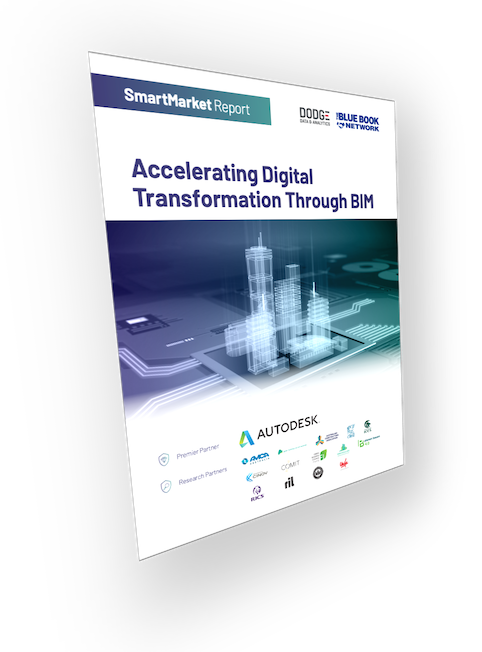

Architecture, engineering and construction (AEC) is increasingly becoming a data-driven industry, and a new study by Dodge Data & Analytics, conducted in partnership with Autodesk, demonstrates that building information modeling (BIM) is at the heart of that initiative. The findings are featured in the Accelerating Digital Transformation Through BIM SmartMarket Report, which provides a thorough overview of how architects, engineers and contractors are deploying BIM, and how they leverage the data from models and processes to improve decision-making and effectively power integrated digital workflows among project team members.
One of the most important findings of the study is the correlation between the depth of engagement with data-driven BIM processes, the intensity of BIM use (the share of projects on which BIM is used), and the degree to which the benefits of using BIM are experienced.
- For architects and engineers, critical benefits—including business benefits like improved client satisfaction and design quality, risk reduction through increased stakeholder buy-in and reduced errors and rework, and additional meaningful sustainability and operational efficiency benefits—are experienced at a much higher level by those who are highly engaged with BIM.
- Contractors with a deeper engagement with BIM also experience crucial benefits to a higher degree, including business benefits like improved win rates and increased percentage of successful projects, quality benefits like a reduced number of constructability issues onsite and reduced defects at handover, and many cost control, schedule and safety benefits, compared with those who are less engaged.
”The findings of this report are consistent with what we hear directly from our customers: the greater the embrace of BIM, the greater returns they see,” said Amy Bunszel, executive vice president, AEC Design Solutions, Autodesk. “BIM is the foundation of the digital transformation of the industry, from design through operations, and as owners begin to look ahead to a digital twin future, all stakeholders should begin their digital journey now.”
The report also suggests that BIM is a critical factor in a company’s larger process of digital transformation. The design and construction industries are continuing to explore the use of data and digital tools to improve the outcomes of projects. The study suggests that BIM is a critical part of the digital transformation journey, with nearly half (47%) of high-intensity BIM users approaching or near to achieving the goal of digital transformation, compared with just 26% of BIM users generally.
The study also offers insight into where the industry currently stands by providing a benchmark for the use of various digital technologies and approaches in five categories: design intelligence tools, innovative construction methods, jobsite technology, smart building technology and data-sharing technology.
- Among those, the top technologies in use currently among BIM users are cloud computing (42%), model-based simulation (33%), virtual/augmented/mixed reality (28%), 3D printing (25%) and reality capture (25%).
- Technologies most strongly poised for growth, with a relatively high percentage who expect to adopt them in the next two to three years, include generative/outcome-based design (20%), 3D printing (19%), model-driven prefabrication (18%), model-driven simulation (18%), robotics/automated equipment (18%), reality capture (17%) and AI/machine learning (17%).
“This study demonstrates that the data revolution is already underway in design and construction,” says Steve Jones, Senior Director, Industry Insights at Dodge Data & Analytics. “As the industry adopts tools like generative design, machine learning, reality capture and automated vehicles, we can expect to see better-performing buildings, more profitable projects, increases in safety and improved efficiency onsite.”
The full report includes more detailed data on critical aspects of BIM deployment, like use of the cloud and a common data environment for digital workflows, the means to maximize the return on investment experienced from BIM and team engagement with the use of BIM. In addition, it also features case studies and thought leader perspectives on the future of BIM. The full report is available for free download here.
